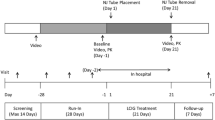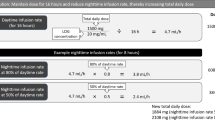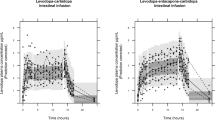Abstract
Motor complications of Parkinson’s disease (PD) are a consequence of pulsatile dopaminergic stimulation from standard oral levodopa therapy. Levodopa–carbidopa intestinal gel (LCIG) is infused continuously via an intrajejunal percutaneous gastrostomy tube. This was the first study designed to characterize the full pharmacokinetic profiles of levodopa, carbidopa, and levodopa metabolite, 3-O-methyldopa (3-OMD) with 16-h LCIG infusion. Nineteen advanced PD patients (mean age, 65 years) who were on LCIG therapy for ≥30 days were enrolled. Patients received their individualized LCIG infusion doses, and serial pharmacokinetic samples were collected. Eighteen patients completed the study; 19 were assessed for safety. Mean (SD) total levodopa and carbidopa doses were 1,580 (403) and 395 (101) mg, respectively. Mean (SD) C avg (μg/mL) were 2.9 (0.84) for levodopa, 17.1 (4.99) for 3-OMD, and 0.22 (0.08) for carbidopa. The degree of fluctuation [defined as (C max − C min)/C avg] in levodopa, 3-OMD, and carbidopa plasma concentrations was very low (0.52, 0.21, and 0.96, respectively) during hours 2–16 of infusion. Accordingly, the within-subject coefficients of variation in levodopa, 3-OMD, and carbidopa concentrations were low (13%, 6%, and 19%, respectively). Three patients (16%) reported ≥1 treatment-emergent adverse event; none were considered severe. Continuous intrajejunal LCIG infusion maintained stable plasma levodopa levels over 16 h. Consistent exposure has been shown to reduce motor and nonmotor complications associated with oral medications. LCIG was well tolerated, consistent with previous reports.


Similar content being viewed by others
References
Hauser RA. Levodopa: past, present, and future. Eur Neurol. 2009;62(1):1–8.
Olanow CW, Agid Y, Mizuno Y, Albanese A, Bonuccelli U, Damier P, et al. Levodopa in the treatment of Parkinson’s disease: current controversies. Mov Disord. 2004;19(9):997–1005.
Nyholm D. The rationale for continuous dopaminergic stimulation in advanced Parkinson’s disease. Parkinsonism Relat disord. 2007;13(suppl):S13–7.
Stocchi F. The hypothesis of the genesis of motor complications and continuous dopaminergic stimulation in the treatment of Parkinson’s disease. Parkinsonism Relat disord. 2009;15 suppl 1:S9–S15.
Olanow CW, Obeso JA, Stocchi F. Continuous dopamine-receptor treatment of Parkinson’s disease: scientific rationale and clinical implications. Lancet Neurol. 2006;5(8):677–87.
Chase TN. The significance of continuous dopaminergic stimulation in the treatment of Parkinson’s disease. Drugs. 1998;55 suppl 1:1–9.
Nyholm D, Lennernas H. Irregular gastrointestinal drug absorption in Parkinson’s disease. Expert Opin Drug Metabol Toxicol. 2008;4(2):193–203.
Kurlan R, Rothfield KP, Woodward WR, Nutt JG, Miller C, Lichter D, et al. Erratic gastric emptying of levodopa may cause “random” fluctuations of parkinsonian mobility. Neurology. 1988;38(3):419–21.
Nutt JG, Woodward WR, Hammerstad JP, Carter JH, Anderson JL. The “on-off” phenomenon in Parkinson’s disease. Relation to levodopa absorption and transport. N Engl J Med. 1984;310(8):483–8.
Shoulson I, Glaubiger GA, Chase TN. On–off response. Clinical and biochemical correlations during oral and intravenous levodopa administration in parkinsonian patients. Neurology. 1975;25(12):1144–8.
Quinn N, Parkes JD, Marsden CD. Control of on/off phenomenon by continuous intravenous infusion of levodopa. Neurology. 1984;34(9):1131–6.
Nyholm D, Aquilonius SM. Levodopa infusion therapy in Parkinson disease: state of the art in 2004. Clin Neuropharmacol. 2004;27(5):245–56.
Nyholm D, Nilsson Remahl AI, Dizdar N, Constantinescu R, Holmberg B, Jansson R, et al. Duodenal levodopa infusion monotherapy vs oral polypharmacy in advanced Parkinson disease. Neurology. 2005;64(2):216–23.
Honig H, Antonini A, Martinez-Martin P, Forgacs I, Faye GC, Fox T, et al. Intrajejunal levodopa infusion in Parkinson’s disease: a pilot multicenter study of effects on nonmotor symptoms and quality of life. Mov Disord. 2009;24(10):1468–74.
Antonini A, Tolosa E. Apomorphine and levodopa infusion therapies for advanced Parkinson’s disease: selection criteria and patient management. Expert Rev Neurother. 2009;9(6):859–67.
Antonini A, Odin P. Pros and cons of apomorphine and L-dopa continuous infusion in advanced Parkinson’s disease. Parkinsonism Relat disord. 2009;15 suppl 4:S97–S100.
Nyholm D, Askmark H, Gomes-Trolin C, Knutson T, Lennernas H, Nystrom C, et al. Optimizing levodopa pharmacokinetics: intestinal infusion versus oral sustained-release tablets. Clin Neuropharmacol. 2003;26(3):156–63.
Nyholm D, Ehrnebo M, Lewander T, Trolin CG, Backstrom T, Panagiotidis G, et al. Frequent administration of levodopa/carbidopa microtablets vs levodopa/carbidopa/entacapone in healthy volunteers. Acta Neurol Scand. doi:10.1111/j.1600-0404.2012.01700.x. © 2012 John Wiley & Sons A/S.
Nyholm D, Johansson A, Aquilonius SM, Hellquist E, Lennernas H, Askmark H. Complexity of motor response to different doses of duodenal levodopa infusion in Parkinson disease. Clin Neuropharmacol. 2012;35(1):6–14.
Nyholm D, Johansson A, Lennernas H, Askmark H. Levodopa infusion combined with entacapone or tolcapone in Parkinson disease: a pilot trial. Eur J Neurol. 2012;19(6):820–6.
Yeh KC, August TF, Bush DF, Lasseter KC, Musson DG, Schwartz S, et al. Pharmacokinetics and bioavailability of Sinemet CR: a summary of human studies. Neurology. 1989;39(11)(Suppl 2):25–38.
Chen C, Cowles VE, Sweeney M, Stolyarov ID, Illarioshkin SN. Pharmacokinetics and pharmacodynamics of gastroretentive delivery of levodopa/carbidopa in patients with Parkinson disease. Clin Neuropharmacol. 2012;35(2):67–72.
Chen C, Cowles VE, Sweeney M, Stolyarov ID, Illarioshkin SN. Pharmacokinetics of levodopa/carbidopa delivered from gastric-retentive extended-release formulations in patients with Parkinson’s disease. J Clin Pharmacol. 2012;52(7):1069–77.
Hauser RA, Ellenbogen AL, Metman LV, Hsu A, O’Connell MJ, Modi NB, et al. Crossover comparison of IPX066 and a standard levodopa formulation in advanced Parkinson’s disease. Mov Disord. 2011;26(12):2246–52.
Bredberg E, Tedroff J, Aquilonius SM, Paalzow L. Pharmacokinetics and effects of levodopa in advanced Parkinson’s disease. Eur J Clin Pharmacol. 1990;39(4):385–9.
Lennernas H, Nilsson D, Aquilonius SM, Ahrenstedt O, Knutson L, Paalzow LK. The effect of L-leucine on the absorption of levodopa, studied by regional jejunal perfusion in man. Br J Clin Pharmacol. 1993;35(3):243–50.
Wade DN, Mearrick PT, Morris JL. Active transport of L-dopa in the intestine. Nature. 1973;242(5398):463–5.
Hidalgo IJ, Borchardt RT. Transport of a large neutral amino acid (phenylalanine) in a human intestinal epithelial cell line: Caco-2. Biochim Biophys Acta. 1990;1028(1):25–30.
Westin J, Nyholm D, Palhagen S, Willows T, Groth T, Dougherty M, et al. A pharmacokinetic-pharmacodynamic model for duodenal levodopa infusion. Clin Neuropharmacol. 2011;34(2):61–5.
Nutt JG, Fellman JH. Pharmacokinetics of levodopa. Clin Neuropharmacol. 1984;7(1):35–49.
Nutt JG, Woodward WR, Anderson JL. The effect of carbidopa on the pharmacokinetics of intravenously administered levodopa: the mechanism of action in the treatment of parkinsonism. Ann Neurol. 1985;18(5):537–43.
Contin M, Riva R, Martinelli P, Albani F, Baruzzi A. Effect of meal timing on the kinetic-dynamic profile of levodopa/carbidopa controlled release [corrected] in parkinsonian patients. Eur J Clin Pharmacol. 1998;54(4):303–8.
Sharpless NS, Muenter MD, Tyce GM, Owen Jr CA. 3-methoxy-4-hydroxyphenylalanine (3-O-methyldopa) in plasma during oral L-dopa therapy of patients with Parkinson’s disease. Clin chim Acta Int J Clin Chem. 1972;37:359–69.
Contin M, Martinelli P. Pharmacokinetics of levodopa. J Neurol. 2010;257 suppl 2:S253–61.
Guttman M, Leger G, Cedarbaum JM, Reches A, Woodward W, Evans A, et al. 3-O-methyldopa administration does not alter fluorodopa transport into the brain. Ann Neurol. 1992;31(6):638–43.
Nutt JG, Woodward WR, Gancher ST, Merrick D. 3-O-methyldopa and the response to levodopa in Parkinson’s disease. Ann Neurol. 1987;21(6):584–8.
Hardie RJ, Malcolm SL, Lees AJ, Stern GM, Allen JG. The pharmacokinetics of intravenous and oral levodopa in patients with Parkinson’s disease who exhibit on-off fluctuations. Br J Clin Pharmacol. 1986;22(4):429–36.
Durso R, Evans JE, Josephs E, Szabo G, Evans B, Fernandez HH, et al. Variable absorption of carbidopa affects both peripheral and central levodopa metabolism. J Clin Pharmacol. 2000;40(8):854–60.
Elia AE, Dollenz C, Soliveri P, Albanese A. Motor features and response to oral levodopa in patients with Parkinson’s disease under continuous dopaminergic infusion or deep brain stimulation. Eur J Neurol. 2012;19(1):76–83.
Kuoppamaki M, Korpela K, Marttila R, Kaasinen V, Hartikainen P, Lyytinen J, et al. Comparison of pharmacokinetic profile of levodopa throughout the day between levodopa/carbidopa/entacapone and levodopa/carbidopa when administered four or five times daily. Eur J Clin Pharmacol. 2009;65(5):443–55.
Stocchi F, Vacca L, Ruggieri S, Olanow CW. Intermittent vs continuous levodopa administration in patients with advanced Parkinson disease: a clinical and pharmacokinetic study. Arch Neurol. 2005;62(6):905–10.
Nyholm D, Lennernas H, Gomes-Trolin C, Aquilonius SM. Levodopa pharmacokinetics and motor performance during activities of daily living in patients with Parkinson’s disease on individual drug combinations. Clin Neuropharmacol. 2002;25(2):89–96.
Stocchi F, Rascol O, Kieburtz K, Poewe W, Jankovic J, Tolosa E, et al. Initiating levodopa/carbidopa therapy with and without entacapone in early Parkinson disease: the STRIDE-PD study. Ann Neurol. 2010;68(1):18–27.
Acknowledgments
This study was sponsored by Abbott. The study was conducted and clinical laboratory tests were performed by Quintiles. The authors thank Dr. Holger Honig and Research Nurses Anne Rüssmann and Sandra Leimbach of the Neurology clinic at Klinikum-Bremerhaven, and the staff of the Neurology clinic at Uppsala University Hospital for their assistance in the completion of the study. Nathan R. Rustay and Michelle M. Tangredi, of Abbott, provided medical writing support in the development of the manuscript.
Financial Disclosure/Conflict of Interest Concerning the Research Related to the Manuscript
Dr. Nyholm has been a study investigator in Abbott-sponsored studies and has received compensation from Abbott for serving as a consultant. Prof. Odin has been a study investigator in Abbott-sponsored studies and has received compensation from Abbott for serving as a consultant and lecturer. Dr. Johansson has been a study investigator in Abbott-sponsored studies and has received compensation from Abbott for serving as a lecturer. Drs Chatamra, Locke, Dutta, and Othman are employees of Abbott and receive compensation including salary, stock, and/or stock options from Abbott.
Funding source
Abbott funded this study and provided the study drug.
Author information
Authors and Affiliations
Corresponding author
Rights and permissions
About this article
Cite this article
Nyholm, D., Odin, P., Johansson, A. et al. Pharmacokinetics of Levodopa, Carbidopa, and 3-O-Methyldopa Following 16-hour Jejunal Infusion of Levodopa-Carbidopa Intestinal Gel in Advanced Parkinson’s Disease Patients. AAPS J 15, 316–323 (2013). https://doi.org/10.1208/s12248-012-9439-1
Received:
Accepted:
Published:
Issue Date:
DOI: https://doi.org/10.1208/s12248-012-9439-1




